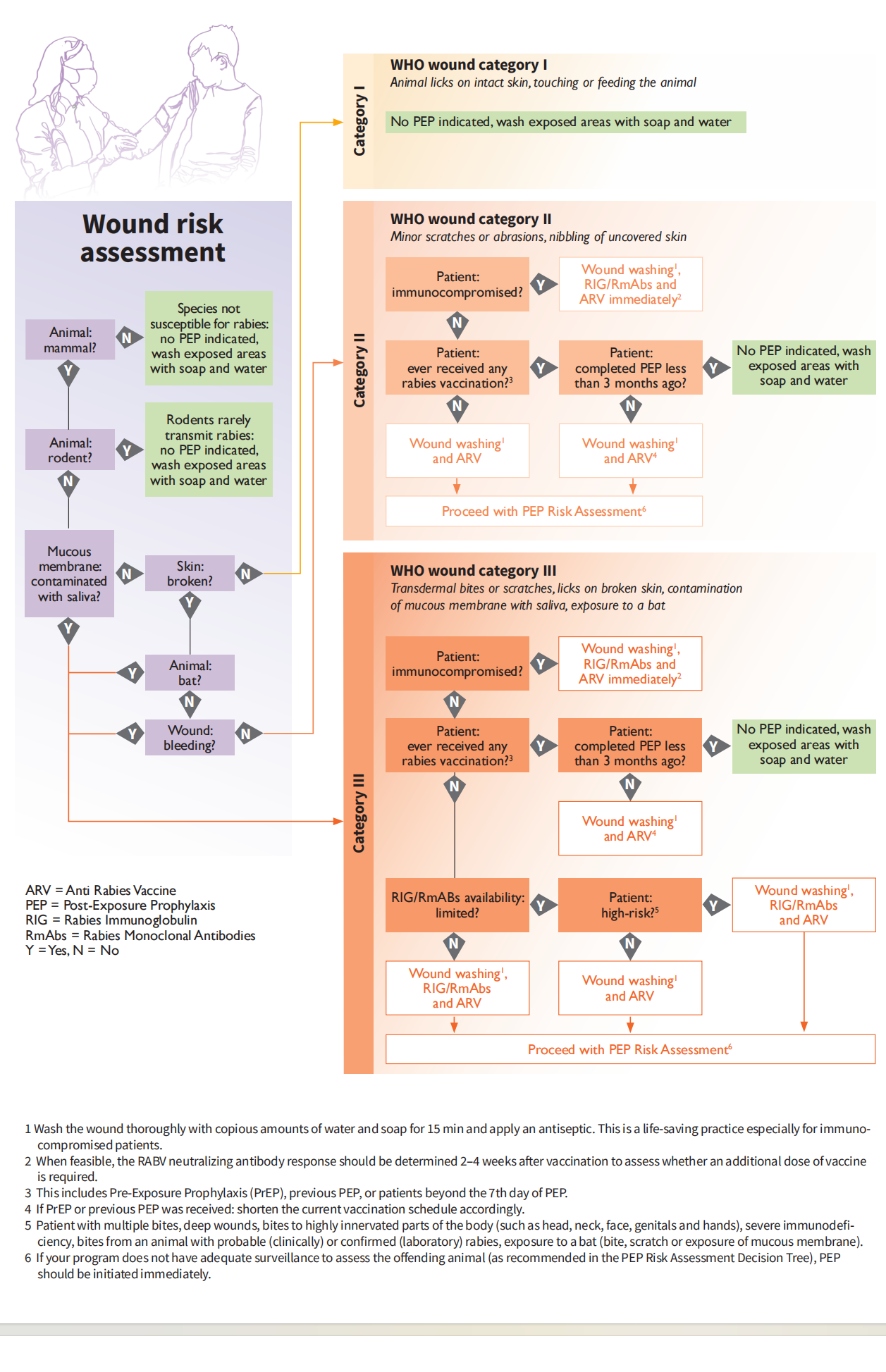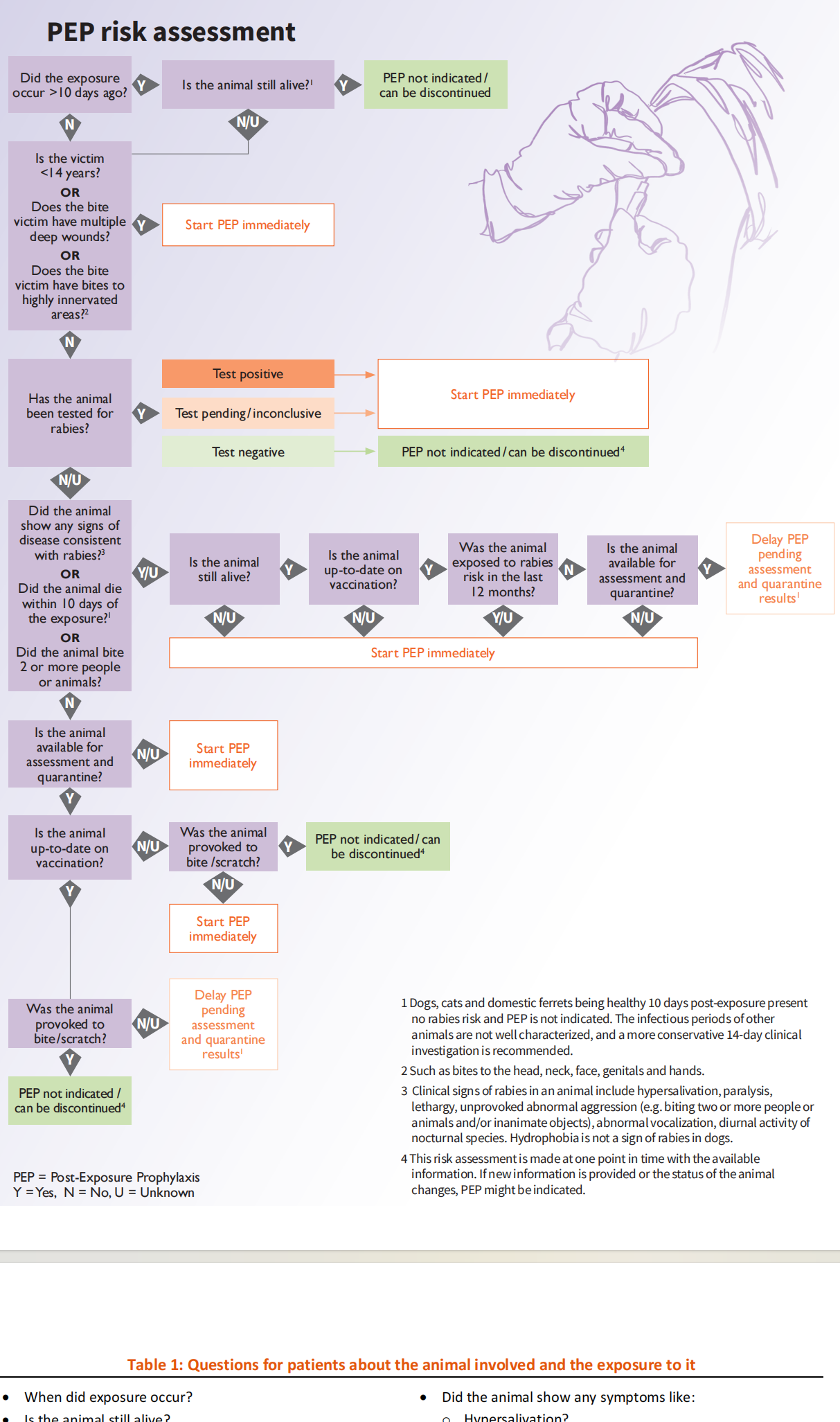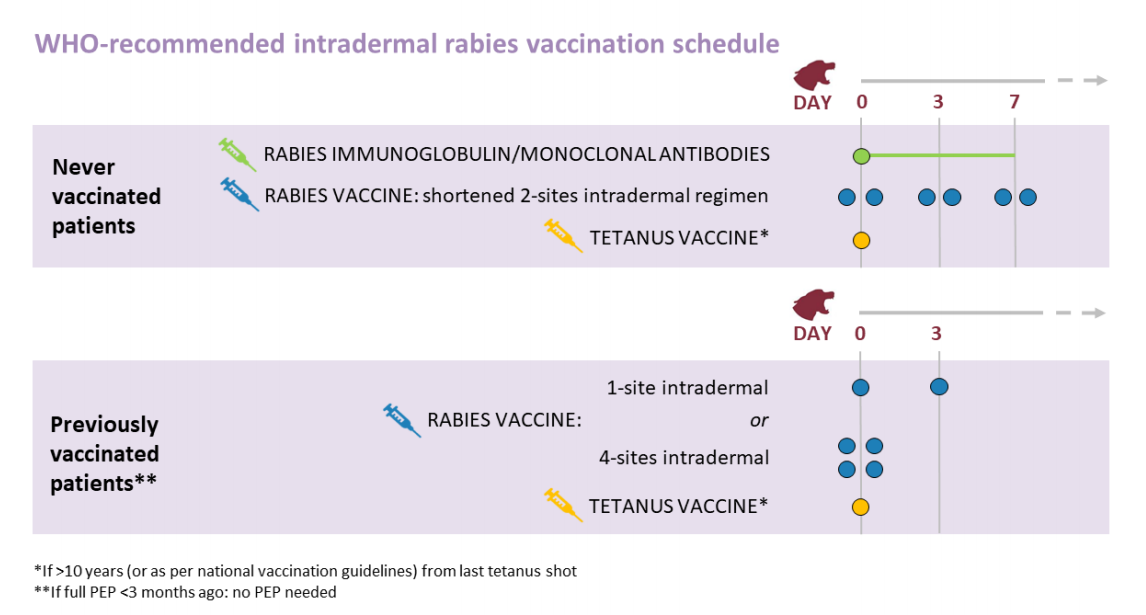WHO发布《狂犬病暴露后预防处置规范流程》及问答
发布日期: 2024-08-01 08:00
访问量:
世界卫生组织(WHO)于2024年5月1日发布了一份关于狂犬病暴露后预防处置规范流程的文件——“Protocol for a well-performed rabies post-exposure prophylaxis delivery: to read along with the decision trees 1- Wound risk assessment and 2 - PEP risk assessment”。文件详细介绍了伤口处理、狂犬病暴露后预防风险评估、狂犬病疫苗接种、狂犬病免疫球蛋白及狂犬病单克隆抗体使用等内容,并对患者及医护人员的一些常见问题和解答进行了整理。(原文链接: https://doi.org/10.2471/B09018)
WHO强调:狂犬病暴露后预防风险评估需要综合伤口严重程度、伤口解剖位置、患者免疫状态、患者狂犬病疫苗接种史,致伤动物情况等多方面因素。为了更好地评估暴露等级,判断是否需要接种狂犬病疫苗和使用被动免疫制剂,WHO绘制了伤口风险评估(Wound risk assessment)、狂犬病暴露后预防风险评估(PEP Risk Assessment)的决策树,可以参考决策树并结合具体情况进行判断、决策。

伤口风险评估决策树

狂犬病暴露后预防风险评估决策树
关于狂犬病疫苗,文件指出:现代、浓缩、纯化的细胞或鸡胚培养的狂犬病疫苗是安全有效的,每瓶疫苗效价应≥2.5 IU,出于节省剂量、成本和时间的考虑,WHO推荐使用缩短的1周皮内暴露后预防接种方案,即第0、3、7天两个点位皮内注射。
文中对应向患者收集的致伤动物信息进行了整理,有利于更好地判断狂犬病风险,并采取相应的措施(Table1)。文件还整理了患者常见问题(Table2A)及医护人员关心的问题(Table2B),并提供了解答。我们将分三篇文章展示,内容仅供参考,具体实施还应结合国内具体情况及相关部门的要求。
Table 1: Questions for patients about the animal involved and the exposure to it
处置前应向患者询问的问题
When did exposure occur?
暴露是什么时候发生的?
Is the animal still alive?
只动物还活着吗?
If not, when did it die?
如果动物已经死了,是什么时候死的?
Was the animal tested for rabies?
该动物是否做过狂犬病检测?
If yes, what is the result of the test?
如果做过,检测的结果是什么?
If no, is the animal available for testing or quarantine?
如果没有做过,能否对该动物进行检测或检疫?
Do you know for sure whether the animal was vaccinated against rabies?
你确切地知道这只动物是否接种过狂犬病疫苗吗?
How did the bite/scratch/exposure happen? What was the animal doing and what were you doing?
咬伤/抓伤/暴露是怎么发生的? 那只动物正在做什么,你在做什么?
Did the animal show any symptoms like:
那只动物有没有表现出以下症状:
Hypersalivation?
唾液分泌过多(多涎)?
Paralysis?
瘫痪(麻痹)?
Lethargy?
昏睡?
Abnormal aggression (e.g., biting two or more people or animals and/or inanimate objects)?
异常攻击行为(例如,咬两个或两个以上的人或动物和/或无生命的物体)?
Strange vocalization?
发出奇怪的声音?
Diurnal activity (in case of nocturnal species)?
昼间活动(对于原本夜间活动的动物)?
Has the animal scratched/bitten other people/animals?
这只动物抓伤/咬过其他人/动物吗?
If yes, inform them about the need for PEP, through local human and animal healthcare providers.
如果是,通过当地的人和动物医疗保健提供者告知他们需要接受PEP。
Table 2A: Questions frequently asked by patients
患者常见问题
I was scratched/bitten a long time ago. Do I still need rabies vaccination?
很久以前我就被抓伤/咬了。我还需要接种狂犬病疫苗吗?
Yes, because the rabies incubation period can be very long.
是的,因为狂犬病潜伏期可能会很长。
If I start rabies vaccination, will I need to change my diet?
如果我开始接种狂犬病疫苗,我需要改变我的饮食吗?
No, you can eat whatever you want.
不需要,你想吃什么就吃什么。
Will there be adverse effects?
会有不良反应吗?
As with any vaccination, there may be adverse effects. But they are likely to be minor (such as redness, pain or swelling at the site of injection) or, even unlikely, mild (such as some fever, headache, dizziness or gastrointestinal symptoms). Serious adverse effects like allergic reactions are rare.
与任何疫苗接种一样,可能会有不良反应。但不良反应一般是轻微的(如注射部位发红、疼痛或肿胀),偶尔有轻度反应(如发烧、头痛、头晕或胃肠道症状)。严重的不良反应,如过敏反应,是罕见的。
What happens if I forget to come for the next vaccination?
如果我忘记来接种下一剂疫苗怎么办?
Make sure you don’t forget by having your relatives/friends remind you about it. But if you forget, come as soon as possible and we will continue the vaccination, not restart it.
让你的亲戚/朋友提醒你接种,确保你不会忘记。如果你忘记了,请尽快来诊室,我们将继续接种疫苗,无需重新开始接种。
I had milk from a rabid animal. Do I need rabies vaccination?
我喝了患狂犬病的动物的奶。我需要接种狂犬病疫苗吗?
No, you don’t need any PEP, but avoid it next time and, anyway, milk should best be boiled before consumption.
不,你不需要任何PEP,但下次要避免这种行为,无论如何,奶在食用前最好煮沸。
I had meat from a rabid animal. Do I need rabies vaccination?
我吃了患狂犬病的动物的肉。我需要接种狂犬病疫苗吗?
No, you don’t need any PEP, but avoid it next time and, anyway, meat should best be cooked before consumption.
不,你不需要任何PEP,但下次要避免这种情况,无论如何,肉类最好在食用前煮熟。
I processed the meat of a rabid animal. Do I need rabies vaccination?
我加工了一只患狂犬病的动物的肉。我需要接种狂犬病疫苗吗?
Probably yes. Tell me more.
可能需要。需要了解更多具体情况。
I was bitten by a mouse/small rat. Do I need rabies vaccination?
我被老鼠/小鼠咬了。我需要接种狂犬病疫苗吗?
No, there is no risk of rabies.
不需要,这种情况没有患狂犬病的风险。
I am pregnant. Is rabies vaccination safe for me and my baby?
我怀孕了。接种狂犬病疫苗对我和我的宝宝安全吗?
Yes.
是的,安全。
I am breastfeeding. Is rabies vaccination safe for my baby?
我正在哺乳期。接种狂犬病疫苗对我的宝宝安全吗?
Yes. 是的,安全。
Table 2B: Questions frequently asked by healthcare providers
医生常见问题
Does the dose of rabies vaccine depend on age or weight?
狂犬病疫苗的剂量取决于年龄或体重吗?
No. Age only determines the site of rabies vaccination: the deltoid area for adults and the anterolateral area of the thighs for children <2 years. Weight only determines the maximum amount of RIG/RmAbs to use: 20 IU/kg of body weight for hRIG, 40 IU/kg of body weight for eRIG.
不,年龄只决定狂犬病疫苗接种的部位:成人为三角肌区,2岁以下儿童为大腿前外侧区。体重仅决定RIG/RmAbs制剂的最大使用量:hRIG使用量为20 IU/kg体重,eRIG为40 IU/kg体重。
Can I change the administration route or vaccine product during the vaccination schedule?
在依照免疫程序接种疫苗期间,我可否改变注射途径或疫苗产品?
Yes, if unavoidable, you can do it. Don’t restart vaccination, just continue it.
是的,在必须的情况下,你可以这样做。不需要重新开始疫苗接种程序,继续接种就可以。
Can I inject the rabies vaccine in the gluteal area?
我可以在臀部注射狂犬病疫苗吗?
No, the vaccine would not be fully absorbed and effective because of the fat present in that body part.
不,由于身体该部位存在脂肪,疫苗不会被充分吸收和发挥效果。
If the wound(s) is on an arm, where should I inject the rabies vaccine?
如果伤口是在手臂上,我应该在哪里注射狂犬病疫苗?
You should inject the vaccine intradermally in the anterolateral area of the thighs or the suprascapular areas. RIG must be injected in the wound(s).
你应该在大腿的前外侧或肩胛上部皮内接种疫苗。一定将RIG注射在伤口处。
If RIG/RmAbs is not available on day 0, should I delay rabies vaccination?
如果在第0天无法应用RIG/RmAbs,我是否应该推迟接种狂犬病疫苗?
No, never. But refer the patient to a healthcare facility where RIG/RmAbs is available, after administering the first dose of rabies vaccine.
不,绝不要推迟。但在接种第1剂狂犬病疫苗后,将患者转诊到可提供RIG/RmAbs制剂的医疗保健机构。
Can I administer RIG/RmAbs later on in the vaccination schedule?
我是否可以在疫苗接种程序开始之后应用RIG/RmAbs制剂?
Yes, if RIG/RmAbs is not available on day 0, but never after day 7. Anyway, RIG/RmAbs should be given as soon as possible after exposure.
是的,当第0天无法获得RIG/RmAbs时(可先接种疫苗,然后尽快注射RIG/RmAbs),但不要晚于第7天(7天以后就不可以用了)。无论如何,暴露后应尽快应用RIG/RmAbs制剂。
Can I give RIG/RmAbs to a patient who has already received any rabies vaccination in their lifetime?
是否可以给曾经接种过狂犬病疫苗的病人应用RIG/RmAbs制剂?
No, thanks to the previous vaccination, there are already demonstrable antibody titres or immune memory cells. In case of re-exposure, 1-site intradermal rabies vaccine administration on days 0 and 3 or 4-sites intradermal rabies vaccine administration on day 0 will produce good antibodies due to anamnestic response.
不,因为之前的疫苗接种,已经有一定的抗体水平或免疫记忆细胞。在再次暴露的情况下,第0、3天1个部位皮内接种狂犬病疫苗或者第0天4个部位皮内接种狂犬病疫苗,通过免疫记忆应答将产生良好的抗体反应。

WHO推荐的狂犬病疫苗皮内接种方案
Should I perform a skin test before administering eRIG?
在使用eRIG之前,我是否应该做皮肤测试?
No, because they poorly predict severe adverse events and their results must anyway not be the reason for not giving eRIG if it is needed. However, all RIG should be administered under conditions that would allow management of an anaphylactic reaction.
不需要,因为皮肤测试很难预测严重的不良事件,而且如果有需要,测试的结果无论如何都不能成为不使用eRIG的原因。然而,所有RIG均应在有急救措施的条件下使用。
Can I give rabies biologicals to a patient who is receiving treatment with chloroquine or hydroxychloroquine?
我可不可以给正在接受氯喹或羟氯喹治疗的病人应用狂犬病生物制剂?
Yes, given the fatal outcome of rabies, there is no contraindication to the concomitant use of any medication.
是的,考虑到狂犬病的致命后果,同时使用任何药物都是没有禁忌的。
Can I give rabies biologicals to a patient who is receiving other vaccines in this period?
我可不可以给在同一时期内正在接种其他疫苗的人注射狂犬病生物制剂?
Yes, given the fatal outcome of rabies, priority is given to rabies biologicals (rabies vaccine and RIG/RmAbs). If the patient receives RIG, live vaccines should be postponed for 3-4 months, if possible.
可以,鉴于狂犬病的致命后果,应优先考虑应用狂犬病生物制剂(狂犬病疫苗和RIG/RmAbs)。如果患者应用RIG,活疫苗应尽可能推迟3-4个月接种。
Should I perform an antibody test on the patient following rabies vaccination?
病人接种狂犬疫苗后,是否需要进行抗体检测?
No, unless the patient is immunocompromised. In this case, a Rapid Fluorescent Foci Inhibition Test (RFFIT) or a Fluorescent Antibody Virus Neutralization (FAVN) test should be performed 2–4 weeks after vaccination to assess whether an additional vaccine administration is needed. Consultation with an infectious disease specialist or an immunologist is advised.
不需要,除非病人免疫功能低下。在这种情况下,应在接种疫苗2-4周后进行快速荧光灶抑制试验(RFFIT)或荧光抗体病毒中和试验(FAVN)检测,以评估是否需要额外剂量的疫苗接种。建议咨询传染病专家或免疫学家。
Are there special recommendations for patients undergoing chemotherapy?
对接受化疗的患者有什么特别的建议吗?
Yes, they are to be treated as immunocompromised patients. So: emphasis on proper wound washing; immediate RIG/RmAbs and rabies vaccine, even if previously immunized, for category-II and -III exposure; complete rabies vaccination course; Rapid Fluorescent Foci Inhibition Test 2–4 weeks after vaccination.
是的,他们将被视为免疫功能低下的病人来治疗。所以:强调正确的伤口清洗;针对II级和III级暴露立即应用RIG/RmAbs和狂犬病疫苗,即使以前已接种过疫苗;完成狂犬病疫苗接种程序;疫苗接种后2-4周进行RFFIT检测血清中和抗体水平。
Are all HIV-infected individuals considered immunocompromised?
是否所有 HIV 感染者都被认为免疫功能低下?
No. HIV-infected individuals who receive antiretroviral therapy and are clinically well and immunologically stable (i.e., normal CD4% > 25% for children aged < 5 years or CD4 cell-count ≥ 200 cells/mm³ if aged ≥5 years) are not considered immunocompromised. 不是的,接受抗逆转录病毒治疗且临床表现良好和免疫稳定的HIV感染者(即:5岁以下儿童正常CD4% > 25%,或者5岁以上儿童CD4细胞计数≥200个/mm³)不被认为是免疫功能低下。
Can intradermal administration be used for immunocompromised individuals or individuals receiving chloroquine, hydroxychloroquine drugs or long-term corticosteroid or other immunosuppressive therapy?
皮内接种疫苗是否可用于免疫功能低下者或接受氯喹、羟氯喹类药物或长期皮质类固醇或其他免疫抑制治疗的患者?
Yes.
可以。
上一篇: 浅谈狂犬病疫苗品牌的更换问题
十个问题教你预防狂犬病 下一篇













